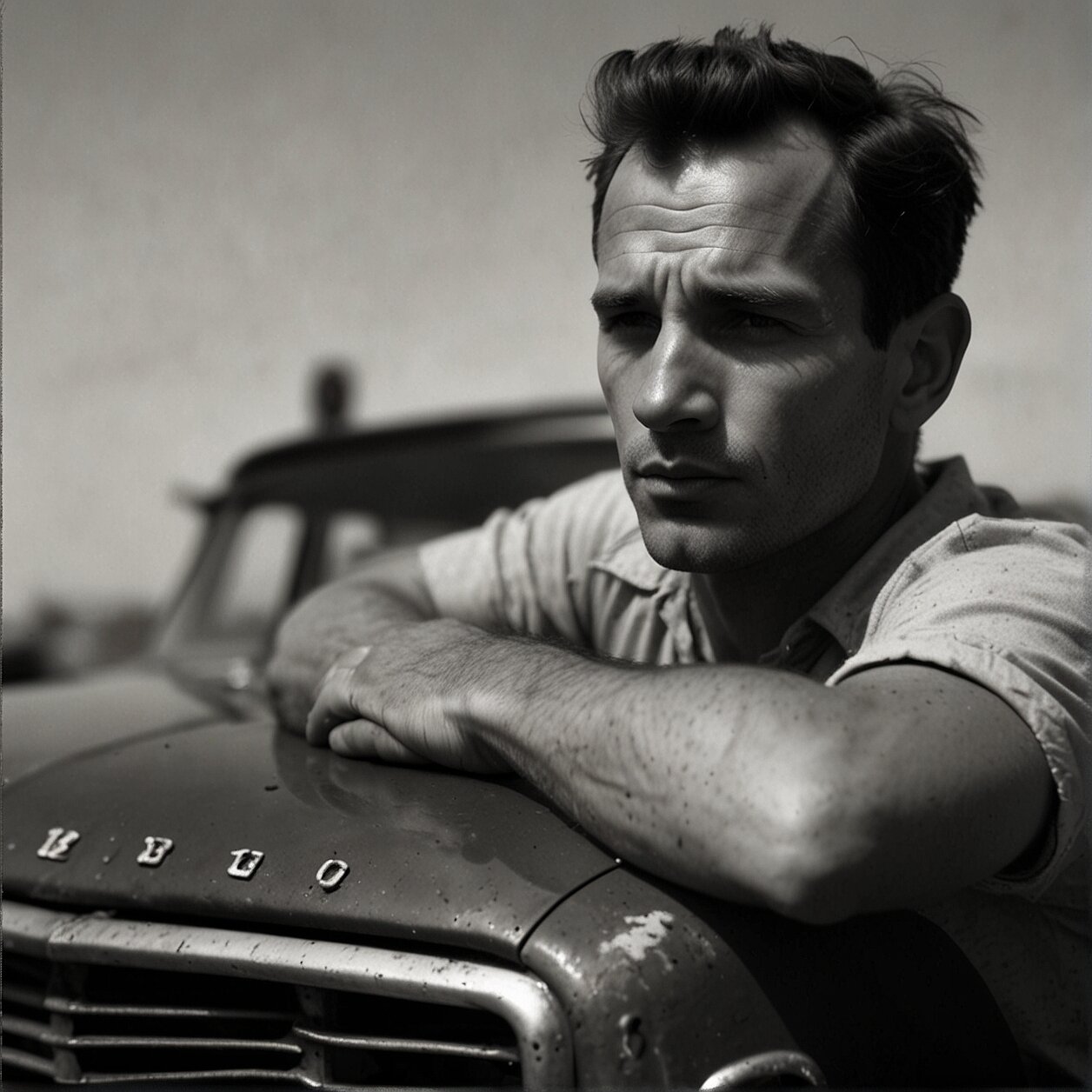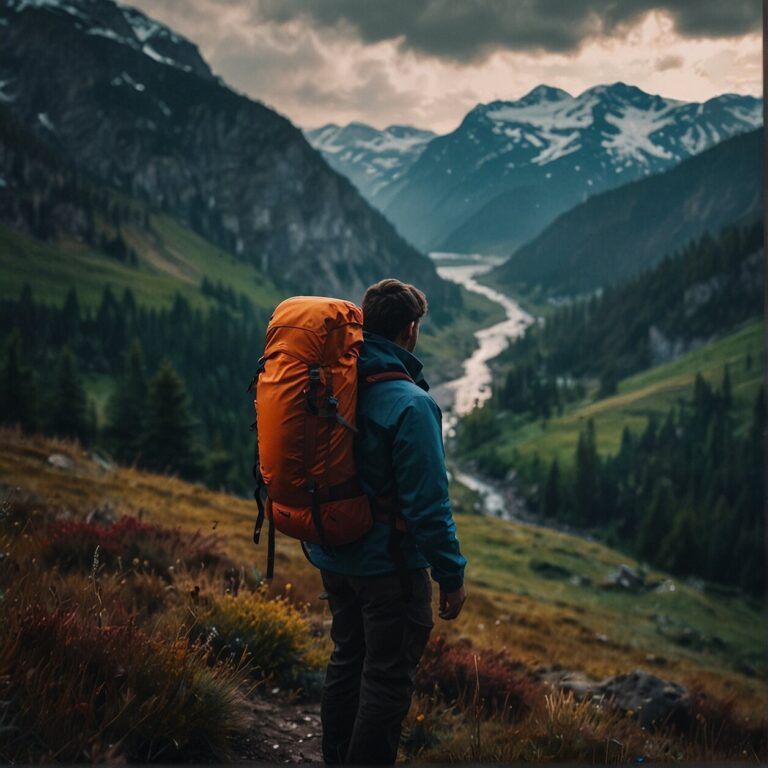On the Road with Kerouac: Revisiting a Classic Road Trip Novel
If you’ve ever felt the allure of the open road, that sense of adventure that only a journey can bring, know that you’re part of a heritage. One that traces its lineage to a novel penned in the mid-20th century. That novel is ‘On the Road’ by Jack Kerouac, a masterwork that swiftly emerged as the travel literature’s pièce de résistance. Its pages brim with both the thrill of exploration and an introspective analysis of the self, making it as relevant today as it was over half a century ago.
“Nothing behind me, everything ahead of me, as is ever so on the road.” – Jack Kerouac, ‘On the Road’
Through its free-spirited and beatnik journey across the USA, ‘On the Road’ painted a new way to experience travel, opening up a world less seen. It shifted the focus from destinations to the journey, from well planned trips to spontaneous adventures, inspiring a generation to strap on their backpacks to discover, first-hand, the charm of the unknown.
- A reread of Kerouac’s classic will uncover the deep-rooted connections between this iconic novel and today’s road trip culture.
- It’ll offer a fresh perspective, helping you translate the essence of ‘On the Road’ into your personal travel experiences.
- It’ll teach valuable lessons about embracing the unknown and highlight the importance of companionship on the road.
Are you geared up to rediscover ‘On the Road’ and find how it still influences how we, as a society, travel? Let’s embark on this exciting literary journey together.
Rediscovering ‘On the Road’: An Insight into Jack Kerouac’s Masterpiece
If you’ve ever had the yearning to just pack your bags and hit the open road, it may not be much of a surprise to learn that Jack Kerouac’s seminal work, ‘On the Road’, played a pivotal role in inspiring that very notion. Following the adventures of Sal Paradise and Dean Moriarty, semi-autobiographical stand-ins for Kerouac and his friend Neal Cassady, it encapsulates an irresistible sense of wanderlust that has profoundly influenced readers for generations.
The novel itself is a testament to the spontaneous and exploratory, woven with themes of freedom, non-conformity, and the relentless search for ‘it’—Kerouac’s elusive term for personal enlightenment or spiritual fulfillment. Written in a breathless, rambling prose that mimics the rhythm of a jazz improvisation, ‘On the Road’ stands as a monument in American letters, vividly capturing the heart and soul of the Beat Generation.
Drawing heavily on Kerouac’s own cross-country road trips and experiences, the narrative propels its readers along with its characters through cities, plains, and mountain ranges. The beauty of this novel lies in its being rooted in such raw and inconsequential reality—a collection of human experiences that appeals universally.
‘On the Road’ represents an America that is simultaneously real and mythic, painting a vibrant portrait of a shifting post-war American landscape. Though the scenery has changed, this timeless piece of literature inspires contemporary adventurers to load up their cars, crank up their playlists, and chase the endless possibilities of the horizon.
A deeper dive into the narrative reveals intricate layers — expressing sentiments of youth’s restiveness and the relentless seeking of life’s purpose, sentiments that evidently still resonate. It has been more than six decades since its publication, but the book’s energy and spirit continue to reverberate in countless road trip plans and personal quests for discovery.

Kerouac’s Influence on Modern Road Trip Culture
Just as Kerouac chronicled his cross-country escapades in ‘On the Road’, countless adventurers have been inspired to embark on their own journeys since the novel’s publication. The influence of his work has permeated not just literature, but also the very fabric of road trip culture – transforming it into a paradigm of exploration, self-discovery, and counterculture.
Consider the contemporary tradition of “freewheeling” your way around the country, stopping off at hidden gems, and letting the journey shape itself. It’s a concept that bears a striking resemblance to Kerouac’s spontaneous, freewheeling style of travel. But Kerouac’s influence extends beyond just the physical act of hitting the open road; it’s also evident in the mental shift that often accompanies road trip culture.
Today’s road trippers are searchers, just like Kerouac and his characters, yearning for experiences beyond the mundane. They seek the kind of authentic, immersive, and transformative experiences that Kerouac eloquently depicted in his writing. This shared yearning, this collective wanderlust, fashions a community of like-minded explorers that is both inclusively diverse and universally connected by a bond formed through shared experiences and common beliefs.
Let’s not forget about the tangible artifacts of Kerouac’s influence. His work has given rise to numerous films, songs, and even branding campaigns touting the virtues of hitting the open road and embracing the unexpected. And of course, there’s the endless stream of modern travel literature, spurred on by the success of ‘On the Road’, forever encouraging us to take that leap, to step out of our comfort zones, and to explore the world with wide-eyed wonder.
Indeed, it is fair to say that Kerouac’s ‘On the Road’ has not only shaped the culture of modern road trips but has left an indelible mark on the collective psyche of a generation of wanderers.
Tracing Kerouac’s Footsteps: Top Road Trip Destinations Inspired by ‘On the Road’
You’ve delved into ‘On the Road’, soaking up the vibrant descriptions, spiritual musings, and the infectious spirit of freedom that pumps through every page. But how can you transform those vivid passages into tangible experiences? Excitingly, some of the most iconic locations, cited in the novel, are still waiting for you to explore them.
For example, you can start in New York City, a central launching point for Sal Paradise and Dean Moriarty’s spontaneous, sprawling adventures. Head to Columbia University, where Kerouac himself studied, and soak up the city’s vibrant literary history. Also be sure to stop by Times Square— an area frequented in the novel and unchanged in its chaotic splendor.
Next, journey to San Francisco and its historic neighborhood, North Beach — a key location in the novel and home of the Beat movement. Visit the City Lights Bookstore, founded by Kerouac’s contemporary and Beat poet, Lawrence Ferlinghetti. It continues to be a vibrant hub for literature enthusiasts and a must-visit for any Kerouac admirer.
Culminate your journey in Denver, Colorado — a recurrent and influential setting in ‘On the Road’. Embark on a trip down Colfax Avenue, dubbed the “longest, wickedest street in America” by Playboy. You’ll find the dazzling lights, diverse crowd, and insatiable craving for life, just as Kerouac described it.
Mirroring the spontaneous nature of Kerouac’s characters, you can create your own path. Embark on a life-altering journey and unveil another gem from America’s vast geographic and cultural tapestry, embracing the spirit of ‘On the Road’ and allowing Kerouac’s narrative to guide your very own odyssey.
Novel Journeys: Translating ‘On the Road’ into Personal Travel Experiences
Curious about turning a literary inspiration into a geographical guidebook? You’re not alone. Consider the many travelers who’ve taken their cues from ‘On the Road’, turning the quintessential road trip narrative into their own personal journey, a testament to the power of Kerouac’s narrative.
How does one translate literature into travel? It’s simple. Revisit the novel’s landmark locations – Kerouac’s narrative spans several states, from the bohemian artistry of New York City, to the dusty landscapes of Denver, the glittering lights of San Francisco, and the sultry rhythms of New Orleans. In fact, ‘On the Road’ forms an unofficial tapestry of America, making it ideal for modern road trippers hungry for a taste of both history and adventure.
Let’s delve deeper into this process. Begin by mapping out the significant destinations from the novel; mark each one out on a physical map or a digital equivalent like Google Maps. This, however, is only the groundwork. Translating ‘On the Road’ into a personal travel experience isn’t about rigidly replicating Sal Paradise’s journey. Rather, it’s about capturing its spirit—combining structured travel planning with spontaneous adventures, just like the protagonists themselves.
Remember, a personal journey based on ‘On the Road’ should be more than just ticking destinations off a list, it’s about embracing the Kerouacian ethos of exploration and self-discovery. Inspired by the novel’s restless spirit, take detours, discover hidden gems, interact with locals, and allow the rhythm of the road to lead you. The aim is to cultivate an open-mindedness towards travel, fostering a deeper understanding and appreciation of different cultures and regions through your own experiences on the road.
And, obviously, don’t forget to pack a copy of ‘On the Road’ for those quiet moments. Engaging with Kerouac’s words amidst the landscapes that inspired them will lead to your own illuminating revelations and connections, thus breathing new life into this cherished travelogue.

Embracing the Unknown: Lessons in Adventure from ‘On the Road’
Have you ever fancied just setting out on a spur-of-the-moment trip with only a vague plan? Or maybe you’ve thought about turning off the GPS and venturing down an unexplored road just to see where it leads? This sense of wanderlust, the craving for adventure and the desire to step out of the known into the unknown – that’s precisely what is at the heart of Jack Kerouac’s ‘On the Road’.
The narrative pulsates with a burning drive to uncover what lies beyond the next bend, or the next town. Each destination is a thrilling question mark, each serendipitous discovery a testament to embracing unpredictability. One lesson that we can draw from Sal Paradise’s (Kerouac’s alter ego) meandering journey is that it is the journey, with all of its unexpected detours and unplanned pit stops, that enriches us and not the destination itself.
Life, after all, is not meant to be a straight path that we plow doggedly through. Much like the journey depicted in ‘On the Road’, it is filled with uncharted territories, chance encounters and lessons learnt along the way. Sal doesn’t shy away from detours – he welcomes them. This spirit of adventure, daring, and openness towards experiences is Kerouac’s tribute to life itself.
‘On the Road’ demonstrates that embracing the unknown does not inevitably lead to chaos and disaster, but instead, it can open doors to transformative experiences and a higher understanding of oneself. So, the next time you set out on a journey, remember to pack a sense of adventure and willingness to detour from the well-trodden path, and who knows, you might just come back with a story worth writing down.
Take a leaf out of Kerouac’s book – travel without expectations and let the spirit of discovery guide you. Let the unknown fascinate you. After all, life is nothing but a journey, and the road serves as a perfect metaphor for it – full of unexpected twists and turns, and ultimately leading you to the destination you are meant to reach.
FAQ’S
Ready to delve deeper into the world of ‘On the Road’? While Kerouac’s work might be complex, it’s never short of intriguing. Presenting a selection of frequently asked questions to fuel your understanding of this legendary novel and its vast implications on modern travel. These queries uncover the inspirations, themes, and timeless relevance of ‘On the Road’, piecing together key insights that define its enduring influence on both literature and real-life journeys.
How did ‘On the Road’ change travel literature?
With its raw energy and free-wheeling narrative, ‘On the Road’ blew a fresh wind through the travel literature genre. Here was a book that wasn’t preoccupied with picturesque sites or ideal itineraries. Instead, it gave readers the grit, thrill, and unpredictability of authentic travel, paving the way for countless imitators in its wake.
‘On the Road’ emphasized the ‘journey’ rather than the ‘destination,’ an approach departure from traditional travel narratives. As you explore the pages of the book, you’re not merely reading about precisely planned journeys. Instead, you’re in the passenger seat, experiencing the spontaneity, tumult, and vivid impressions of a nomadic life.
In the wake of Kerouac’s memoir, travel literature morphed into a more exploratory genre, focused on the experiences and growth of the traveler themselves. Consequently, literature became less about ‘seeing’ places and more about ‘feeling’ them. It was an influential shift that brought a mesmeric, personal touch to travel writing and influenced authors like Pico Iyer and Anthony Bourdain.
So next time you pick up a travel memoir that prioritizes raw experiences over curated landscapes, remember the impact of ‘On the Road.’ It’s a testament to Kerouac’s enduring impact that his work’s influence continues to ripple through more than just roadtrip narratives; it has fundamentally changed the way we write, and read, about travel itself.
What was Jack Kerouac’s inspiration for ‘On the Road’?
When it comes to Jack Kerouac’s inspiration for ‘On the Road’, a complex mix of real-life experiences, literary influences, and profound personal insights were at play. Kerouac not only drew from the world around him, but also from the worlds within famous novels he admired.
In many ways, Kerouac’s own life served as the source material for his adventurous narratives. He was renowned for using his powerful memory as the wellspring for much of his writing. His real-life travels across the US and Mexico with his ragtag group of friends immensely fed into the lively characters and spontaneous journeys portrayed in ‘On the Road’.
Furthermore, Kerouac envisaged his life’s literary output as one great book, with each individual work presenting a chapter of the grand story. This mindset, infusing every experience with literary potential, was vital in shaping ‘On the Road’, turning his escapades into an iconic travel novel that blurred the lines between fiction and reality.
Yet, Kerouac’s inspirations weren’t limited to personal experiences. Literary giants Marcel Proust, Ernest Hemingway, and Thomas Wolfe, among others, held a significant sway over his writing style. Proust’s influence, in particular, is palpable in the way Kerouac used memory as a narrative tool, echoing Proust’s exploration of memory and time in ‘In Search of Lost Time’.
Ultimately, the inspiration for ‘On the Road’ is a testament to Kerouac’s diverse influences and unique vision. It’s a brilliant fusion of literature and life, memory and moment, transforming everyday adventures into a rich narrative tapestry that continues to rivet readers and inspire road trippers.
What are some iconic road trip destinations inspired by ‘On the Road’?
Let’s get you on the road, winding your way through the landscapes that inspired Kerouac’s iconic novel. Dust off your map or plug these destinations into your GPS for an enlightening journey.
The first pit stop has to be Columbia University in New York City. The birthplace of the Beat Generation, it’s here where the young Kerouac along with Ginsberg, Carr, Hal Chase, and others intertwined their lives and started sowing the seeds of a literary movement that would later shake America to its core. Make sure to check out the famed Butler Library that served as a sanctuary for these budding writers.
Your journey then moves west, crossing the Mississippi River, a key symbol in ‘On the Road’, representing the division between the conventional East and the rebellious West in Kerouac’s narrative. A quiet moment by the river, soaking in its grandeur, might make you understand why Kerouac penned such poetic lines in its honor.
Turning the pages further leads you to Denver, Colorado, a city frequently visited by the characters in the novel. Denver, with its bustling jazz scene and bohemian spirit, encapsulates their quest for freedom and exploration. Places like Larimer Street and Five Points Neighborhood still hold the echo of that rebellious spirit.
Finally, let’s cruise towards the Pacific, the final destination and the ultimate symbol of liberation in ‘On the Road’. San Francisco, the ‘end of the road’, is synonymous with Kerouac and his wild literary pack. A visit to the City Lights Bookstore, a Beat Generation mecca, is mandatory for any devotee of ‘On the Road’.
Mind you, this is just a snapshot of the vast world that ‘On the Road’ encompasses. This journey is as much about the places you’ll visit as it is about the moments of introspection and the spirit of adventure that you’ll bring along.
What can we learn from ‘On the Road’ about the American Dream?
To dive into Kerouac’s exploration of the American Dream in ‘On the Road’, we first need to realize that his envisioning of this dream is dynamic, not static. It is a shift away from the post-World War II ideals of prosperity, nuclear family, and home ownership. Instead, Kerouac, through his protagonist Sal Paradise, presents a uniquely alternative interpretation brimming with the thirst for freedom, encounter with raw experiences, and relentless pursuit of the ‘now’.
Call it a counter-narrative, but it’s a necessary jolt to the conventional understanding of the American Dream. In the novel, the dream is not about arriving at a comfortable suburban life but is in the chaotic journey itself, the unquenchable desire to explore, discover, and experience. There’s a continuous seeking, in the vast landscapes and late-night conversations, jazz music and restless road trips, colorful personalities and fleeting connections.
In this sprawling narrative, the American Dream isn’t necessarily an attainable end-goal but more of a consistent thirst for chasing freedom, seeking human connections, and celebrating the present moment. It is spontaneous and enthusiastic, a beautiful frenzy of the adventurous spirit. This interpretation, paradoxically, presents a dream that is intangible and elusive, hence constantly prompting the desire to keep moving, to continue searching.
‘On the Road’ challenges us to redefine our own American dreams and questions whether personal fulfillment really lies in the ticking off of societal norms and expectations. It’s an invitation to break free from the limitations of traditional success metrics and explore a world wilder and more fulfilling.
Therefore, the learning from ‘On the Road’ about the American Dream is about exploring a more personal dream, as opposed to conforming to societal expectations. It dares us to explore uncharted territories, embrace the unknown, and relish the journey versus the destination. Truly, it enriches our understanding with alternative views on the pursuit of happiness and personal fulfillment and paints a picture that the American Dream can be as multifaceted and varied as the individuals dreaming it.
How does ‘On the Road’ explore the theme of friendship?
It’s not an overstatement to say that ‘On the Road’ is a tribute to friendship’s power. At the very heart of this novel, you’ll find the deep bond of camaraderie between Sal Paradise (Jack Kerouac’s alter ego) and Dean Moriarty (based on Kerouac’s real-life friend Neal Cassady). This relationship, colored by shared experiences and personal transformation, is the book’s emotional linchpin.
The friendship in ‘On the Road’ is far from perfect. It’s at times raw and stringent, teetering on the brink of conflict. But isn’t that what real friendship is about? It’s a spontaneous relationship not bound by traditional societal norms. Kerouac depicts their tumultuous friendship as both a source of life’s greatest joys and its profound enough sorrow.
Kerouac, through the character of Sal, also introduces us to an expansive network of eccentrics, outcasts, and visionaries – the hobos, artists, intellectuals and laborers that populate the varied landscapes of America. These fleeting but meaningful encounters along the road reflect a broader concept of friendship. You enter the lives of strangers, share moments, stories and learn from them, only to part ways, carrying a fragment of them in your hearts. The idea resonates with the endless possibilities and transient nature that characterizes road travel.
So, pick up ‘On the Road’, and travel with Sal and Dean. Experience the electric pace, candid dialogues, and soul-stirring reflections that so quintessentially blend friendship and exploration. It is a journey that has inspired countless modern adventurers, yourself included, to bravely step into the unknown, forge meaningful connections and immerse in the authentic experience of road trips.







